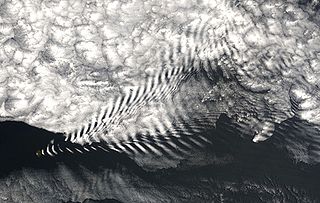Difference between revisions of "AY Honors/Weather/Answer Key"
| (4 intermediate revisions by the same user not shown) | |||
| Line 7: | Line 7: | ||
Orographic lift is demonstrated in many places in the world, but few examples are as clear as those in the [[Northwestern United States]]. In the states of [[Washington]] and [[Oregon]], places on the sea-facing side of coastal mountains see over 100 inches (over 2.5 m) of [[precipitation (meteorology)|precipitation]] per year. These locales are on the side of the [[mountain]]s which are in the path of [[storm]] systems, and therefore receive the moisture which is effectively squeezed from the clouds. However, on the other side of the [[mountain]]s, sometimes as little as 15 miles (25 km) away, annual [[precipitation (meteorology)|precipitation]] can be as low as 8 inches (200 mm) per year. | Orographic lift is demonstrated in many places in the world, but few examples are as clear as those in the [[Northwestern United States]]. In the states of [[Washington]] and [[Oregon]], places on the sea-facing side of coastal mountains see over 100 inches (over 2.5 m) of [[precipitation (meteorology)|precipitation]] per year. These locales are on the side of the [[mountain]]s which are in the path of [[storm]] systems, and therefore receive the moisture which is effectively squeezed from the clouds. However, on the other side of the [[mountain]]s, sometimes as little as 15 miles (25 km) away, annual [[precipitation (meteorology)|precipitation]] can be as low as 8 inches (200 mm) per year. | ||
| − | + | This phenomenon is also prominent on the [[Hawaii]]an [[island]] of [[Kauai]]. | |
| − | + | ||
| − | + | Orographic lift can create [[lenticular cloud]]s and [[wave cloud]]s on the leeward side of mountains. | |
==See also== | ==See also== | ||
| Line 15: | Line 15: | ||
* [[Rain shadow]] | * [[Rain shadow]] | ||
| − | [[Category:Climate forcing]] | + | [[Category:Climate forcing agents]] |
| + | |||
[[fr:Onde orographique]] | [[fr:Onde orographique]] | ||
Revision as of 04:00, 9 May 2006

Orographic lift occurs when an air mass is forced from a low elevation to a higher elevation as it moves over rising terrain. As the air mass gains altitude it expands and cools adiabatically. This cooler air cannot hold the moisture as well as warm air and this effectively raises the relative humidity to 100%, creating clouds and frequently precipitation.
Orographic lift is demonstrated in many places in the world, but few examples are as clear as those in the Northwestern United States. In the states of Washington and Oregon, places on the sea-facing side of coastal mountains see over 100 inches (over 2.5 m) of precipitation per year. These locales are on the side of the mountains which are in the path of storm systems, and therefore receive the moisture which is effectively squeezed from the clouds. However, on the other side of the mountains, sometimes as little as 15 miles (25 km) away, annual precipitation can be as low as 8 inches (200 mm) per year.
This phenomenon is also prominent on the Hawaiian island of Kauai.
Orographic lift can create lenticular clouds and wave clouds on the leeward side of mountains.
